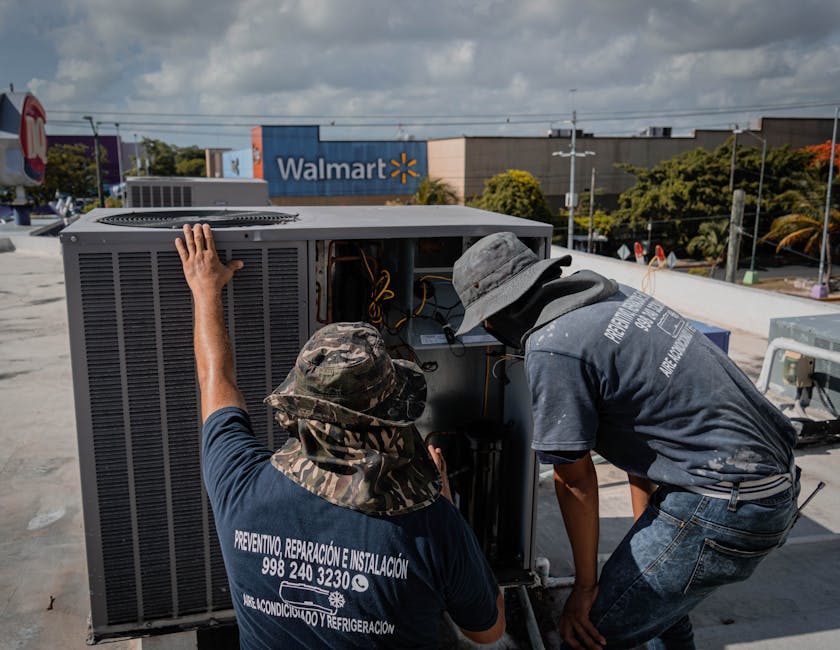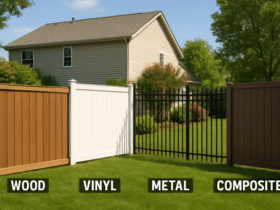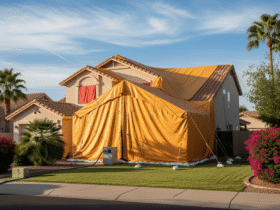The Unseen Hero: Why Regular HVAC Care is Non-Negotiable

Our HVAC system is the quiet workhorse of our homes, diligently regulating temperatures and ensuring a comfortable indoor environment year-round. Yet, its critical role often goes unnoticed until something goes wrong. Neglecting this essential system can lead to a cascade of problems, from inconvenient breakdowns to skyrocketing utility bills and even compromised indoor air quality.
The truth is, regular HVAC maintenance isn’t just about fixing things when they break; it’s a proactive strategy that offers substantial returns. It’s an investment in your home’s comfort, your family’s health, and your financial well-being. Think of it as a comprehensive insurance policy for one of your most expensive home appliances.
Maintaining your HVAC system helps ensure its efficiency, extends its operational life, and prevents unexpected disruptions. It safeguards against the common culprits of system failure—dirt and neglect—and ensures that your home remains a sanctuary of comfort, regardless of the weather outside.

The Financial Impact of a Healthy System
One of the most compelling reasons to prioritize HVAC maintenance is its direct impact on your wallet. A well-maintained system operates more efficiently, consuming less energy and translating into significant savings on your utility bills. The average home spends nearly $1,900 a year on energy, with almost half of that dedicated to heating and cooling costs. This makes your HVAC system a prime candidate for energy optimization.
Clean HVAC systems have been scientifically proven to save both money and energy. Studies show that reductions in fan/blower energy consumption ranging from 41% to 60% are seen when HVAC systems are cleaned. This is because a dirty condenser, for instance, can cause your air conditioning to use up to 10% to 20% more energy than usual. Organizations, from homeowners to large businesses, can save 5-20% annually on energy bills simply by following operations & maintenance (O&M) best practices.
Beyond daily energy consumption, regular maintenance is your best defense against costly breakdowns. Preventive maintenance can avoid up to 95% of breakdowns, saving you from emergency repair costs that can average $350 or more. These unexpected repairs often strike at the most inconvenient times—during peak heatwaves or cold snaps—when demand for technicians is high and parts might be scarce. By catching minor issues early, you prevent them from escalating into major, expensive problems.
Extending Your System’s Lifespan
Just like a car, your HVAC system is a complex piece of machinery with many moving parts. Over time, wear and tear are inevitable. However, dirt and neglect are the top causes of heating and cooling system failure and inefficiency, significantly accelerating this process. When components like motors lack lubrication, increased friction occurs, leading to higher electricity consumption and premature component failure. Dirty coils reduce the system’s ability to cool or heat your home effectively, forcing it to run longer and harder, which further increases energy costs and shortens the equipment’s life.
Regular maintenance addresses these issues head-on. By cleaning coils, lubricating moving parts, and ensuring all components are functioning optimally, you reduce strain on the system. This proactive approach helps your HVAC unit operate within its intended parameters, preventing premature failure and extending its overall lifespan. While HVAC systems typically last 15 to 25 years, this longevity is largely dependent on consistent care. A well-maintained system is more likely to reach the higher end of this spectrum, ensuring you get the most out of your significant investment. Moreover, many manufacturers require routine servicing to maintain warranty coverage, protecting you from unexpected repair costs down the line.
Your Seasonal HVAC Maintenance Checklist

To keep your HVAC system running smoothly and efficiently throughout the year, a consistent maintenance schedule is key. This typically involves a combination of seasonal professional tune-ups and regular DIY tasks. Unfortunately, fewer than half of homeowners (47%) report having had HVAC servicing within the last year, a statistic that highlights a common oversight. However, scheduling a professional HVAC system tune-up at least once a year can help identify and address potential issues before they become costly problems.
Essential DIY HVAC Maintenance Tasks
As a homeowner, there are several simple yet impactful maintenance tasks you can perform to keep your HVAC system in good shape between professional visits. These tasks are crucial for maintaining efficiency and preventing minor issues from escalating.
- Air Filters: This is perhaps the most critical and easiest DIY task. A dirty filter can increase energy costs and damage your equipment, leading to early failure. Aim to inspect your air filters monthly and replace them at least every 1-3 months. You should never wait more than 90 days to replace an air filter. Homes with pets, or occupants with allergies or respiratory conditions, should change filters more frequently, around every 30-60 days. Changing your air filter is a straightforward process, and you can find helpful resources like this video guide on how to change an air filter to walk you through the steps.
- Outdoor Unit Cleaning: Your outdoor unit (condenser for AC, or heat pump) can accumulate dirt, leaves, grass clippings, and other debris. This debris can obstruct airflow and reduce the unit’s efficiency. Regularly clear away any visible debris from around the unit. Additionally, ensure that plants, weeds, shrubs, and other vegetation are kept at least 18 inches away from the outdoor unit to allow for proper airflow.
- Vents and Registers: Inside your home, ensure that all supply and return vents and registers are clean and unobstructed. Furniture, drapes, rugs, or even dust buildup can block airflow, forcing your system to work harder. Periodically vacuum or wipe down these vents to maintain proper circulation.
- Condensate Drain Line: In cooling mode, your AC produces condensation. This water drains through a condensate line. A plugged condensate drain can cause water damage and affect indoor humidity levels, or even shut down your system. Periodically check the drain line for clogs and clear any blockages you find.
By consistently performing these essential tasks, you contribute significantly to your HVAC system’s efficiency and longevity.
The Role of Ductwork and Thermostats
Beyond the main HVAC unit, two other critical components significantly impact your system’s overall efficiency and your home’s comfort: ductwork and thermostats.
Ductwork: The network of ducts running through your home is responsible for distributing conditioned air. However, in houses with forced-air heating and cooling systems, about 20% to 30% of the air that moves through the duct system is lost due to leaks, holes, and poorly connected ducts. This means you’re paying to heat or cool air that never reaches your living spaces, leading to significant energy loss. Leaky or poorly insulated ductwork can lead to uneven temperatures, increased energy bills, and reduced indoor air quality as dust and pollutants can be drawn into the system. Sealing and insulating accessible ductwork can dramatically improve airflow efficiency and reduce energy waste. Airflow problems alone can reduce your system’s efficiency by up to 15 percent.
Thermostats: Your thermostat is the control center of your HVAC system. An outdated or improperly programmed thermostat can lead to energy waste. Upgrading to a smart thermostat, especially one that has earned the ENERGY STAR certification, can offer significant benefits. These devices allow for precise temperature control, programmable schedules, and even remote access, helping you optimize your home’s climate while minimizing energy consumption. Replacing your old heating and cooling system with one that’s earned the ENERGY STAR can save you nearly $140 annually, and a smart thermostat is a key player in maximizing those savings. Ensure your thermostat is properly calibrated and programmed to reflect your daily schedule and comfort preferences.
Why Professional HVAC Maintenance is Crucial
While DIY tasks are important, certain aspects of HVAC maintenance require the expertise, specialized tools, and technical knowledge of a certified professional. These are the critical checks that ensure not only efficiency but also the safety and long-term health of your system.
A professional HVAC technician performs a comprehensive inspection and tune-up that goes far beyond what a homeowner can safely or effectively do. This includes:
- Refrigerant Level Checks: Too much or too little refrigerant will make your system less efficient, increasing energy costs and reducing the life of the equipment. Only a certified technician can accurately measure and adjust refrigerant levels and check for leaks.
- Electrical Connections: Faulty electrical connections can cause unsafe operation of your system and reduce the life of major components. Technicians will inspect and tighten all electrical connections, ensuring safety and preventing potential fire hazards.
- Burner Combustion and Heat Exchanger Inspection: For heating systems, proper burner combustion is vital for efficiency and safety. An improperly operating gas (or oil) connection is a fire hazard and can contribute to health problems. Technicians will inspect the heat exchanger for cracks (which can lead to carbon monoxide leaks) and ensure safe, efficient operation.
- Lubrication of Moving Parts: While you might lubricate some visible parts, professionals ensure all internal moving parts, especially in motors, are properly lubricated to prevent friction and reduce electricity consumption.
- Coil Cleaning (Evaporator and Condenser): While you can clear debris from the outdoor unit, professional cleaning of both the indoor evaporator coil and outdoor condenser coil is essential. Dirty coils reduce the system’s ability to cool or heat, forcing it to run longer and increasing energy costs and reducing equipment life.
- Condensate Drain Clearing: A professional will thoroughly clear the condensate drain to prevent water damage and address potential issues affecting indoor humidity levels.
These detailed checks and adjustments are what make professional maintenance invaluable. For a truly thorough check that ensures every component is working safely and efficiently, you need a service that provides Wright comprehensive HVAC maintenance. Their expertise helps uncover hidden problems, optimize performance, and extend the life of your system.
DIY vs. Professional: Knowing Your Limits

Understanding the distinction between tasks you can handle yourself and those requiring a certified professional is paramount for effective HVAC maintenance. While we encourage homeowners to take an active role in their system’s care, recognizing when to call in the experts is crucial for safety, efficiency, and warranty compliance. Fewer than half of homeowners (47%) report having had HVAC servicing within the last year, underscoring the need for greater awareness about the importance of professional intervention.
Homeowner-Friendly Tasks
Empowering homeowners with simple, safe maintenance tasks can significantly contribute to the overall health of an HVAC system. These routine checks and cleanings help maintain efficiency and can often prevent minor issues from escalating.
Here’s a list of simple maintenance tasks homeowners can perform:
- Changing Air Filters: As discussed, this is a monthly to quarterly task depending on your home environment.
- Cleaning Around the Outdoor Unit: Regularly remove leaves, grass clippings, and other debris that can obstruct airflow. Ensure at least 18 inches of clearance around the unit.
- Clearing Vents and Registers: Vacuum or wipe down all supply and return vents to ensure unrestricted airflow. Check that no furniture or drapes are blocking them.
- Checking Thermostat Batteries: Replace batteries in non-hardwired thermostats annually or when the low-battery indicator appears to ensure consistent operation.
- Inspecting Condensate Drain for Flow: Periodically check the clear PVC pipe for standing water or blockages. If you see buildup, a simple flush with a vinegar solution can often clear it.
- Listening for Unusual Noises: Pay attention to any new or strange sounds coming from your system during operation. While not a fix, early detection can help you describe the problem accurately to a technician.
When to Call a Certified Technician
While DIY efforts are beneficial, many critical maintenance tasks require specialized tools, training, and knowledge that only a certified HVAC technician possesses. Attempting these tasks without proper qualifications can be dangerous, lead to further damage, or even void your system’s warranty.
Here’s a comparison of tasks to highlight when professional help is essential:
DIY Tasks Professional Tasks Changing air filters Checking and adjusting refrigerant levels Cleaning around outdoor unit Inspecting and tightening electrical connections Clearing vents and registers Lubricating internal motors and bearings Checking thermostat batteries Cleaning evaporator and condenser coils thoroughly Simple condensate drain inspection Checking gas pressure and burner combustion Listening for unusual noises Inspecting heat exchanger for cracks Testing system safety controls Assessing overall system performance and efficiency You should always call a certified technician if you suspect:
- Refrigerant Leaks: These can be harmful to the environment and indicate a serious problem that impacts cooling/heating efficiency. Too much or too little refrigerant will make your system less efficient, increasing energy costs and reducing the life of the equipment.
- Electrical Issues: Faulty electrical connections can cause unsafe operation and reduce the life of major components, posing a significant fire hazard.
- Mechanical Repairs: Any internal component that requires dismantling or specialized tools for repair or replacement.
- Gas Pressure Adjustments or Combustion Problems: Improperly operating gas (or oil) connections are a fire hazard and can contribute to health problems, requiring immediate professional attention.
- Persistent Water Leaks: While you can clear a simple condensate drain, persistent leaks might indicate a more complex issue. A plugged condensate drain can cause water damage and affect indoor humidity levels.
- Dirty Coils: Dirty coils reduce the system’s ability to cool your home and cause the system to run longer, increasing energy costs and reducing the life of the equipment. Professional cleaning is often needed for the indoor coil.
For complex diagnostics and repairs, relying on a company with a record of Airdrie Air’s top-rated HVAC maintenance ensures the job is done correctly and safely. Their expertise provides peace of mind and safeguards your system’s integrity. Preventive maintenance can avoid up to 95% of breakdowns, and that largely relies on the thoroughness of professional service.
Warning Signs: Is Your HVAC System Crying for Help?

Even with regular maintenance, HVAC systems can develop issues. Recognizing the warning signs early can prevent minor problems from escalating into major, costly repairs or complete system failures. Forty-two percent of homeowners say they’ve experienced HVAC system issues during heat waves, highlighting how often problems manifest during peak demand. Neglecting regular maintenance on your AC unit can lead to a number of problems, including reduced airflow, increased energy bills, and a higher likelihood of malfunctions and breakdowns.
Here are common indicators that your HVAC system needs attention:
- Strange Noises: While some operational sounds are normal, grinding, squealing, banging, or persistent rattling noises often signal a problem with a motor, fan, or other internal components.
- Unusual Odors: A burning smell could indicate an electrical issue, while a musty smell might point to mold or mildew in the ductwork or evaporator coil. A gas smell, particularly from a furnace, requires immediate action and professional help.
- Weak Airflow: If air coming from your vents is weak, it could be due to a clogged air filter, blocked ducts, a failing blower motor, or issues with the fan.
- Inconsistent Temperatures: If some rooms are too hot while others are too cold, your system might be struggling with airflow, duct leaks, or a faulty thermostat.
- High Humidity: An air conditioner that isn’t properly dehumidifying your home, leading to sticky or clammy indoor air, might have a refrigerant issue or a clogged condensate drain.
- Increased Energy Bills: A sudden or gradual spike in your utility bills without a corresponding change in usage is a strong indicator that your HVAC system is losing efficiency and working harder than it should.
- Frequent Cycling: If your system turns on and off too frequently (short-cycling), it could be oversized, have a clogged filter, or be experiencing electrical or refrigerant problems.
- Water Leaks: Puddles or drips around your indoor or outdoor unit can indicate a clogged condensate drain, a frozen evaporator coil, or a damaged pan.
Repair or Replace? Making the Right Call
When your HVAC system starts showing its age or experiencing frequent issues, you’ll eventually face a critical decision: repair it again or invest in a new system. This choice involves weighing immediate costs against long-term savings and comfort.
Consider these factors:
- System Age: HVACs typically last 15 to 25 years. If your system is over 15 years old, especially if it’s experiencing frequent breakdowns, it might be nearing the end of its functional life. Repairing an aging system can be like throwing good money after bad.
- Repair Frequency and Cost: If repairs are becoming more frequent or the cost of a single repair approaches 30-50% of the cost of a new unit, replacement often makes more financial sense. While an HVAC repair averages $350 nationwide, major repairs can quickly add up.
- Energy Efficiency: Older systems are significantly less efficient than modern, ENERGY STAR-certified models. Replacing your old heating and cooling system with one that’s earned the ENERGY STAR can save you nearly $140 annually. These energy savings can offset a portion of the replacement cost over time.
- Home Value: A new energy-efficient HVAC system could raise your home’s value by up to 7%, making it an attractive upgrade for potential buyers.
- Warranty Coverage: Most standard homeowners’ insurance policies do not cover claims when an HVAC unit is damaged because of general wear and tear or poor maintenance. A new system comes with a fresh warranty, providing peace of mind.
- Comfort and Technology: Newer systems offer improved comfort features, quieter operation, and smart technology integration that older units simply can’t match.
While a new HVAC system costs an average $7,500 and possibly upward to $12,500, the long-term benefits in terms of energy savings, improved comfort, increased home value, and reduced repair headaches often justify the initial investment, especially for systems well past their prime.
The Hidden Benefits: A Healthier, Safer Home
Beyond comfort and cost savings, a well-maintained HVAC system plays a crucial role in safeguarding your family’s health and the safety of your home. It’s the silent guardian against a host of unseen threats, contributing significantly to your indoor environment.
Breathe Easier with Better Indoor Air Quality
Indoor air quality (IAQ) is a critical component of a healthy home, and your HVAC system is at its forefront. The Environmental Protection Agency (EPA) reports that the number of pollutants in the air is 2 to 5 times higher in indoor air compared to outdoors. Your HVAC system, particularly its filtration, is designed to capture these airborne contaminants.
When filters are dirty or coils are caked with grime, the system’s ability to filter air effectively is severely compromised. This leads to:
- Increased Allergens: Dust mites, pollen, pet dander, and mold spores circulate freely, exacerbating allergies and asthma symptoms.
- Respiratory Issues: Higher levels of particulate matter and other indoor pollutants can irritate the respiratory system, leading to coughing, sneezing, and more serious conditions over time.
- Mold Prevention: A plugged condensate drain can cause water damage and affect indoor humidity levels, creating an ideal breeding ground for mold and mildew within your system and ductwork.
- Odor Control: A clean system helps circulate fresh air and prevents stale, musty odors from lingering.
Clean filters and coils are crucial for healthy air. Regular maintenance ensures that your system is not only heating and cooling efficiently but also actively improving the air you breathe. Clean HVAC systems have been scientifically proven to save money and energy, and this efficiency directly translates to better air filtration and circulation.
Safety Considerations: Moreover, a well-maintained HVAC system is a safer system. Improperly operating gas (or oil) connections are a fire hazard and can contribute to health problems, including carbon monoxide poisoning. Professional technicians check these critical connections during maintenance, ensuring they are secure and functioning correctly. Faulty electrical connections are another concern, potentially leading to system failure or electrical fires. A dirty filter can increase energy costs and damage your equipment, leading to early failure, but it can also restrict airflow to a degree that compromises safety in some heating systems. By addressing these potential hazards, HVAC maintenance provides an invaluable layer of protection for your home and loved ones.
Frequently Asked Questions About HVAC Care
How often should I really change my air filter?
The general recommendation is to inspect your air filter monthly and replace it at least every 1-3 months. However, this frequency can vary significantly based on several factors. For homes with pets, or occupants with allergies or respiratory conditions, changing filters more frequently—around every 30-60 days—is highly recommended to ensure optimal airflow and air quality. If you live in a dusty environment or use your system heavily, you might also need to change it more often. The key is never to wait more than 90 days to replace an air filter, as a dirty filter significantly reduces efficiency and can damage your equipment.
Is annual professional maintenance worth the cost?
Absolutely. The cost of an annual professional HVAC tune-up is a minor investment compared to the potential expenses of neglecting your system. Preventive maintenance can avoid up to 95% of breakdowns, saving you from emergency repairs that can average $350 or more, and potentially reach up to $3,000. In contrast, a new HVAC system costs an average of $7,500 to $12,500. Regular maintenance ensures your system runs at peak efficiency, which translates directly into lower energy bills. It also helps preserve your system’s warranty and extends its lifespan, maximizing your return on investment.
What are the biggest consequences of skipping maintenance?
Neglecting regular HVAC maintenance can lead to a cascade of costly and inconvenient problems. The most significant consequences include:
- Reduced Efficiency and Higher Energy Bills: A dirty, unmaintained system has to work harder to achieve desired temperatures, consuming more energy and driving up your utility costs.
- Increased Risk of Breakdowns: Maintenance can avoid expensive repairs or premature system replacement if done at recommended intervals. Without it, minor issues can quickly escalate into major malfunctions, often occurring during extreme weather when you need your system most.
- Shortened Equipment Lifespan: Dirt and wear and tear accelerate the degradation of components, leading to premature system failure and the need for an expensive replacement much sooner than expected.
- Poor Indoor Air Quality: Dirty filters and coils allow allergens, dust, and pollutants to circulate freely, negatively impacting respiratory health.
- Voided Warranty: Many manufacturers require proof of annual professional maintenance to honor their warranties, leaving you to cover the full cost of repairs.
- Safety Hazards: Unchecked electrical connections or gas lines can pose fire or carbon monoxide risks.
- Water Damage: A plugged condensate drain can cause water damage and affect indoor humidity levels.
Conclusion: Proactive Care for Year-Round Comfort
Our HVAC system is fundamental to our home’s comfort, health, and energy efficiency. As we’ve explored, regular maintenance is not merely a suggestion; it’s a non-negotiable aspect of responsible homeownership. From the significant financial savings on energy bills and averted repair costs to the extended lifespan of your equipment and the tangible improvements in indoor air quality, the benefits are extensive and far-reaching.
By embracing a proactive approach—diligently performing simple DIY tasks and scheduling professional tune-ups annually—you ensure your HVAC system operates at its best. This small investment provides immense returns in comfort, savings, and peace of mind, preparing your home for whatever the seasons may bring. Don’t wait for a breakdown to realize the value of maintenance; make it a priority today for year-round comfort and a healthier, safer home.











